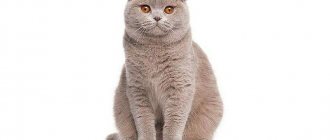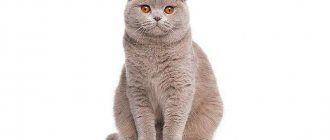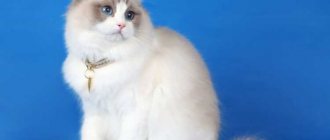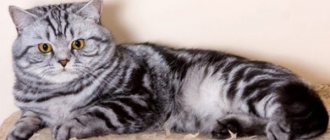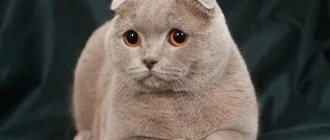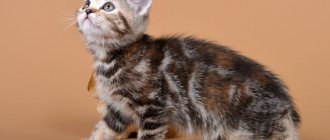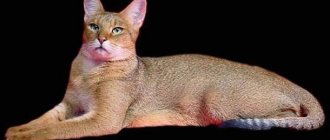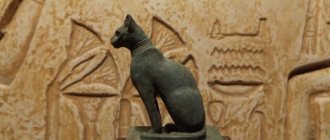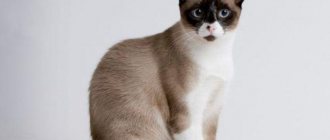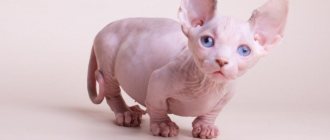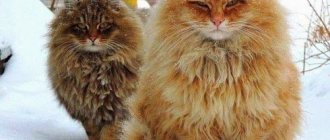Plush cats attract people with their cute round shapes and naively wide eyes. The red monochromatic color is rare and it is usually the males that are red. Therefore, the red British cat is deservedly on the list of one of the most desirable pets. He will become his master's best friend, patiently waiting for him to get home from work and not bothering him.
Briefly about the British
The British cat breed was first introduced in the second half of the 19th century, although images of animals visually very similar to the British can be found in manuscript books from the 7th and 8th centuries. Officially, breed standards were approved much later, in 1980. The breed is recognized by all world phenological organizations.
British cats were popular back in the 19th century
The British are characterized by a large, massive and muscular build. Males weigh on average about 6–8 kg, but some individuals reach 10 kg. Females are more graceful and smaller. The body is powerful, slightly squat, well molded, with a wide chest and massive shoulders, strong, slightly short legs.
A large round head with a wide skull, set on a strongly developed and short neck. The cheeks are convex and thick, the chin is strong and firm. Short ears with slightly rounded tips are set wide apart. Not too long, but quite proportionate, the tail thickened at the base, slightly tapering to a rounded tip.
All British cats have a massive, large build.
The British breed is famous for its short, plush and very thick coat with a high-quality dense undercoat. It is extremely pleasant to the touch, silky and tender.
Description of the appearance of the fluffy handsome man
A ginger British cat should have a solid red color. The coat should be free of marks, patterns and white hairs. The villi should be the same color from root to tip. Solid color is rare, often in males. The coat of red British kittens can be short or long. Soft and dense to the touch, it resembles plush toys. The body of cats is strong and muscular, with a wide chest. The limbs are short, the color of the pads and nose can be from brick to bright red, but pink can also be found.
As for the head, it is large, round, with thick cheeks. The British cat has small ears with rounded ends. Her eyes are large, round and wide-set. Their color is gold and orange with a characteristic brick-colored eyeliner. The tail of these pets is short, but thick, with a rounded tip. British sizes range from medium to large. Weight can reach 10 kg. Life expectancy is about 15 years, depending on living conditions and care.
Sometimes kittens of the Scottish and British breeds are confused, since both are born with erect ears. However, the British Fold cat of red color does not exist in nature.
Breed standards for the color of British Reds
The structure of the coat of red cats of the British breed should be the same as that of all its other varieties. The standard allows both a short, elastic, soft coat with a densely padded undercoat, and a long, flowing coat. The bright fiery red color inherent in these cats is more correctly called red (according to genetics).
Fur color, ideally, according to standard requirements, should be uniform and even (solid). Each hair is completely dyed in the same tone, from the base to the very tip. The color of the undercoat is only red, without tan or highlights. No white spots or even hairs are desirable.
The wool should be evenly colored
The brighter, richer and more intense the red hue of the fur, the more valuable that particular individual is.
The skin, pads on the paws, as well as the nose mirror are according to the standard slightly darker than the main tone (close to brick or terracotta color), but lighter shades are also acceptable. Stains and inclusions are considered defective. The color of the iris is exclusively yellow (orange, copper, golden), without the greenish edging characteristic of many cats.
Table: EMS encodings according to WCF and FIFe standards
| Sign | Code | Name | |
| Breed | BRI | British | British |
| Coat color | d | Red (orange) | solid red, orange, gold or tan |
| Iris color | 62 | yellow, golden | orange |
| Ears set | 71 | straight ears | straight ears |
| Tail length | 54 | longy | normal |
Visually, red British cats will seem like ordinary yard saffron milk caps to an uninitiated person, but meanwhile they are very rare specimens in the cat world.
British Reds should have red or yellow eyes.
lop-eared british
Representatives of the Scottish breed have kittens with straight ears. The fold-eared cat becomes later. They are often confused with the British. The breeds are really similar. However, red-haired Britons have small, wide-set, straight ears. The red fold-eared British cat is a myth.
red british cat photo
Features of the red color of the British
The British ginger cat is a representative of the “red” color, which is characterized by a deep and uniform dark color along the entire length of the coat. Some animals have slightly lighter or, on the contrary, darker hairs in the paws, tail or forehead - this is normal. The eye color of quadrupeds is copper or bright yellow. The standard breed is usually monochromatic. If there are deviations, then the cat’s color has a different name.
Animals are unusual and original. Some note that these British cats resemble foxes.
Video “Ginger cat of Scottish breed”
A video about a funny Scottish cat who can sit on its tail and play funny will give you a moment of positivity.
Was this article helpful?
Thank you for your opinion!
The article was useful. Please share the information with your friends.
Yes (100.00%)
No
X
Please write what is wrong and leave recommendations on the article
Cancel reply
Rate the benefit of the article: Rate the author ( 3 votes, average: 5.00 out of 5)
Discuss the article:
Genetics of the red (red) color of the British
The British Shorthair breed allows for approximately 250 different color combinations, with solid colors playing a major role. Ginger cats are not unique here, they are often found in litters and were once even quantitatively ahead of the blue-gray color that is considered traditional for the British.
All the tools of the genotype take part in the process of color formation: chromosomes and genes, alleles, loci and pigmentation.
- The main role in the formation of the red color in the British is played by the pigment pheomelanin - elongated ellipsoidal granules that reflect light in the range of red, yellow and orange shades.
- Genes are a library of hereditary data that is passed on from parents to offspring and continues the chain of ancestral connections ad infinitum.
- Alleles come in different forms that genes can take on. They are located on certain parts of the chromosomes - in the example of red British cats, this is a very important point.
- Locus is the location of a gene (allele) in an ordered list of chromosomal compounds.
There are 19 pairs of chromosomes in a cat's set. They store the hereditary instructions, and any deviation from the norm ends in an uncontrolled mutation. British redheads are not subject to this risk, as they are an ancient breed with an established genotype.
Genes and chromosomes that influence the formation of red color are distributed as follows:
- The O (orange) gene is responsible for the production of the red pigment pheomelanin in the British (and not only in them). It has only one permanent locus attached to the X chromosome, which determines the sex of the future kitten.
- The O gene exists in 3 alleles: OO (natural red), Oo (red and black tortoiseshell British), oo (red is blocked and does not cause pheomelanin pigmentation). The final example in practice means only one thing - the cat will be black.
- For ginger cats, there are 3 color combination options: OO, oo and Oo. For red British cats, only 2 options are possible - O and O, since they have one X chromosome.
- According to the laws of genetics, a British cat inherits the orange gene from its mother. Therefore, in a pair with a red mother and a blue-gray father, male kittens will definitely receive the properties of the red gene, and the female cats will be tortoiseshell, cream or blue.
This is interesting! There are many more ginger British cats than cats, because boys receive the color gene only from their mother, and girls inherit the properties of both parents.
All British red coats have a tabby pattern on their coats. It is formed under the influence of the A gene (agouti) and exists in two alleles: dominant A and paired homozygous aa. In the second case, agouti suppresses another important component of the genotype - the T (tabby) gene, which is responsible for the ornamentation on the fur coat.
The unique property of the red color is that aa (not agouti) has no effect on it. Therefore, all red British cats are always tabby.
The L gene is also involved in the formation of red color. Thanks to him, purebred British cats have short and thick hair.
Important! The birth of a red or cream female kitten suggests the presence of a dominant O gene in the genotype of two British parents. Only direct pedigree lines influence the external characteristics of the offspring.
How to get color
The genetic feature of the fiery color is the impossibility of obtaining a cat of a single color. The tabby pattern is always present, although not pronounced.
Red (cream) color is usually denoted by the letter “O”, meaning red (orange). The "O" mutation is found on the female "X" chromosome. Such a gene is called sex-dependent.
The brightness of the color depends on the “D” gene: with the dominant gene (D), the pigment lies evenly, the kittens are bright red; with recessive (gene d) - vice versa: cream.
Color of kittens
The most stringent requirements apply to red British kittens, which are “orange” in color. To get the desired result, breeders had to change the gene line of the presented breed, which became possible thanks to the red chromosomes of the Persians.
We recommend reading: Burmilla cat: photo, description, character, prices, nurseries, reviews
Babies' fur can be either long or short - stuffed. The coloring is solid, although some have tortoiseshell tabby markings. Some quadrupeds have white hairs. If they do not disappear with age, then such animals will not be allowed to exhibit, because they will be considered “spoiled.”
Particular attention is paid to the eyes. They should be orange or gold. There can be no talk of any green halo. As for the mirror of the nose, its color is either brick or red.
Red-haired lop-eared British
British ginger kittens should have a rich and even shade. The eyes are only copper or bright red in color. The red tone is a solid one, so it should be beautiful and deep. Usually males can boast of this shade. In females, the tortoiseshell color predominates. This is due to the orange gene with chromosome X. In cats, everything is different, if chromosome 1X contains the red gene, then the quadruped will be orange-copper. At the same time, if a female has a similar combination, she will turn out to be a tortoiseshell. The red tint is only possible if there is chromosome 2X with the red gene.
Breeders note that red British Shorthair cats are not only bright representatives of their breed, but also original with their own individuality. They are called real aristocrats - reserved, calm and independent. Although from time to time cats can give vent to their feelings - play, cuddle.
Due to the fact that the animal has short hair, there are no problems with caring for the four-legged animals. It is enough to brush your pet twice a week with a special brush so that the coat shines and always looks flawless.
Important! To ensure that the golden color is always bright and shimmering, you need to bathe the kitten with special shampoos several times a month, and then comb it thoroughly.
Many people like their babies to have soft, silky fur, but this is a drawback. According to standards, children should have a thick undercoat and moderately hard. The same applies to the main coat. If kittens have long hair, then the babies may be considered “rejected” and will not be allowed to participate in exhibitions in the future.
Features of color
At exhibitions, strict requirements are put forward for pets. A Briton with a uniform, rich red color is allowed to participate. The hair is uniform throughout its length. The standard allows partial tabby coloring on the forehead in the form of the letter “M”, paws, and tail; inclusions in the form of white wool are rejected. The paw pads and nose are a brick-red, terracotta shade a tone darker than the cat's fur. Eye color is red and yellow.
British shorthair
The British Shorthair cat is characterized by a plush coat, round eyes and small ears. The coat is harsh, dense with a thick, uniformly colored undercoat. Soft is a disadvantage.
Character and who is suitable for
Some believe that color does not affect character, but breeders do not agree with this. Ryzhikov are rightly compared to the patient and self-possessed Englishmen. Representatives of the breed will never get in the way or spend a long time begging for something from their owners. For them, this is akin to humiliation, which they will never reach.
Four-legged animals are very smart, many people note this. It is enough to show kids just once where to go to the toilet, and they will never change this place.
Babies are clean from childhood, so they do not require any special care. Fold kittens quickly become attached to those with whom they live, but at the same time they will not be affectionate with their owners. The British rarely sit on their hands, and if they do it, it is only because they themselves decided so. Cats, like true coquettes, sometimes like to lie on their backs, exposing their tummy to be smelled. Animals believe that they are equal members of the family, so they want to be taken into account. This concerns the choice of place - the British will sleep and lie only where they want. This cat breed should be fed strictly according to the clock.
Some people worry that if you have such a pet at home, you won’t have anyone else, but this is not so. The British get along well with other animals, be it cats or even dogs. Many representatives of the breed even love children; they feel that babies are weak, so they protect them and are always nearby. British ginger cats are not the ones who will suddenly jump on children or show aggression towards them. If the animals don’t like something, they will simply turn around and leave.
Four-legged animals can play only when they are in the mood. If they want to be alone, then not a single toy or not a single animal living nearby will force them to abandon their plans.
The red-haired Briton doesn't need to pay much attention. When a feline representative wants to make himself known, he will come and make himself known. Although animals prefer solitude and silence. If you want to teach kids something: to go to the litter box, to scratch their claws in one place, then this needs to be done from a young age. It will no longer be possible to teach anything to mature four-legged animals.
Character: advantages and disadvantages
The red-haired pet has a calm and reserved character, distinguished by its independence.
It is not for nothing that the red British cat is considered an aristocrat and has maximum advantages. It is impossible not to notice the calm disposition of the pet. The plush cat is independent and reserved. It easily gets along with its owners and remains loyal for life. Although the British do not like to show their love, they are not aggressive and get along well with other animals.
If your pet is in a good mood, he can not only play with children, but also endure all the children's pranks. However, in general the British do not like noise, shouting and fuss. Preference is given to solitude and a quiet, calm environment. Cats lead a sedentary lifestyle, hiding in a secluded place, they can sleep for about 20 hours. The manners of British cats are combined with good mental abilities. They understand what can and cannot be done.
Red pets will never scratch furniture, tear wallpaper, ride on curtains or shit in the wrong place. Cats easily get accustomed to feeding time, finding a sleeping place and a litter box. It is impossible not to note the cleanliness of the British breed. The plush saffron milk saffron can lick its coat several times a day. And he does this with special care. The restraint of the British does not allow them to shout for food. Cats will sit quietly near the bowl and wait to be fed.
The disadvantages of the breed include the desire to throw objects off surfaces and play. In addition, cats do not like to sit in their arms and receive affection. Instead, they prefer to do things that, in their opinion, are more important: hide in bags, packages and boxes. Perhaps the main disadvantage of red purebred British cats is the rarity of the breed. This results in the high cost of the British.
Pros and cons of British redheads
All British cats, regardless of coat color, are distinguished by their independence and even a certain amount of unhealthy selfishness. At home, they prefer privacy and communicate with the owners only when they themselves want to. The expression “a cat walks on its own” applies to the British breed in the best possible way.
It has been noticed that ginger cats are more loyal to family members than their blue-gray or black “relatives”.
Interestingly, homebodies and introverted people rarely choose Britons as pets. This cat is ideal for those who work a lot and are often away from home.
The animal easily tolerates loneliness, so after enjoying the solitude to the fullest, in the evening the Briton kindly greets the owner and even sits on his lap with pleasure. And this is enough to make your vacation cozy and comfortable - a good home, a strong family and a ginger cat that greets the owner with a quiet purr.
Who would suit a red-haired Briton?
Many people think that color does not affect character. Breeders have a different opinion: British redheads are considered to be real aristocrats. They do not bother their owner by meowing. They don’t get in their way when begging for anything. They are reserved and independent. They lead a sedentary, quiet lifestyle.
Smart by nature. They become toilet trained instantly, all you have to do is show the kitten the litter box once. British cats are clean and do not require careful, long-term care. Cats have good health.
British ginger cats are attached to their owners, but are not known for their affection: they rarely allow themselves to be stroked and do not sit on laps. They get along with both children and animals: a dog will become a good friend for a Briton. They play with children according to their mood, often ignoring them. When a person pays increased attention to his person, he will not release his claws and will prefer to leave. They love solitude, and therefore are suitable for busy and business people.
Rules for caring for your pet's appearance
British cat grooming includes:
- Regular brushing of fur. The procedure is carried out 1-2 times a week using a special comb.
- Ear cleaning. To do this, you will need cotton swabs, disks, and an aqueous solution of chlorhexidine or a special liquid for ear care. You need to clean it once every 2-3 weeks.
- Wiping the eyes with a cotton pad with boiled water or special solutions. You can buy wet wipes for animals at the pet store. Small kittens' eyes are treated daily; adults can do this less often.
- Brushing your teeth once a week. You will need a brush and animal paste. It does not need to be washed off after completing the procedure.
- Trimming nails with a special device. It is also advisable to provide your pet with a scratching post.
- Bath 2-3 times a year using cat shampoo and conditioner. When washing, you need to make sure that no water gets into the animal’s ears or eyes. To avoid this, hold the cat by the base of its neck with one hand. Do not dry the fur with a hair dryer.
Many animals swallow hairballs when licking. This can negatively affect digestion. To ensure that the hair ball easily leaves the animal’s body, a special malt paste is used. It coats the walls of the stomach and intestines and helps remove hair. Instead of paste, you can give your pet fresh cat grass.
The appearance of the animal depends not only on compliance with hygiene rules, but also on its state of health. General care includes:
- Prevention and treatment of helminthic infestations. If your pet does not leave the house, you need to give special medications every 6 to 8 months. Animals that roam freely on the street require the procedure more often - once every 3 months.
- Fight against skin parasites - fleas, ticks. For this purpose, special shampoos, drops, and collars are used.
- Regular vaccination against viral and fungal diseases. 10 days before vaccination, deworming is carried out.
- Replenishing the deficiency of vitamins and microelements with the help of special supplements for animals.
We recommend reading: English Setter: description, dog character, care, photo
Conditions of detention
A British kitten requires special care and constant care, but an adult pet can live independently. The first household items will be a tray, as well as a bowl and a scratching post. Your pet should be toilet trained as a child. It is recommended to purchase a large tray to make it easier for your cat to adapt. It is important to remember that the British actively dig out litter, so the container for the pet’s natural needs should be quite deep.
If the scratching post does not cause any interest in your pet, you should trim the claws with special scissors once every 2 weeks. The procedure must be carried out before mating or before an exhibition. To comb and remove excess hair, you will need a rubber or hard bristle brush.
You cannot care for the British dog’s skin with a hard metal tool, so as not to damage the skin and undercoat of your pet.
The cat will need a place to sleep and toys. Moreover, after purchasing various things, you need to constantly use them. A cat quickly gets bored of playing with objects without another animal or person. You need to constantly communicate with a Briton and spend a lot of time.
The most significant drawback of the British cat is excessive shedding at least 2 times a year. Because of this, the pet requires careful grooming. Cats need to be brushed once a week. The number of procedures increases with the arrival of winter, as in cold weather the cat's fur begins to grow quickly. It is recommended to comb the animal every day.
The British do not like bathing, but to maintain the health of the coat it is necessary to wash it at least 2 times every 6 months . During the bath, you need to make sure that water does not get into your pet's ears or eyes. To do this, hold your pet by the base of its neck. You will need to buy special shampoos for animals with soft fur. It is strictly forbidden to use a hair dryer for drying.
To prevent a hairball that gets inside your pet during self-washing from leading to digestive upset, you can use special pastes. The product easily removes hair from the body without harm to the pet. Plaques in the ears and around the eyes should be wiped with cotton swabs or napkins previously moistened with hydrogen peroxide. Kittens need to wipe their eyes every day - small pets are characterized by increased tear production.
It is necessary to regularly inspect your pet's claws for fungal infections. To reduce the risk of developing diseases, you should take your cat for vaccination every year. Deworming needs to be done every 3 months. One of the procedures to eliminate parasites should be done 10 days before vaccination.
Vaccination and deworming are carried out only for healthy pets.
The right approach to feeding
Having given preference to natural nutrition, it is necessary to include raw lean meat in the animal’s diet.
An important aspect of keeping British cats at home is a healthy diet. Tawny British kittens up to six months of age should receive food at least 5 times a day. Older pets are fed twice a day: morning and evening. Description of the basic rules of proper nutrition for the British:
- fresh food;
- food at room temperature;
- feeding at the same time;
- removing leftover food from the bowl;
- the presence of a cup of clean water next to the food plate.
As for the products for feeding the British, it is allowed to feed the pet with store-bought food, but many owners prefer to pamper their cats with natural food. An unbalanced diet can harm the animal. The menu of British cats includes lean raw meat. The product is pre-frozen for 2 days to get rid of pathogenic microorganisms. Preference is given to beef, which is cut into small cubes along with films and veins. It is permissible to give such meat daily. This food improves chewing reflexes and protects teeth from the formation of tartar deposits.
It is allowed to include turkey, chicken, and rabbit in food. The British also love offal, especially liver. Boiled fish and fermented milk products are allowed in limited quantities. This food will provide the body with the required nutrients and vitamins. It is useful to add porridge, eggs and fresh vegetables to the menu.
Subtleties of content: how to deal with the red-haired beast?
In order for the furniture to remain intact, it is recommended to equip the cat with her resting place, and install a scratching post there.
Having decided to get a British kitten, it is important to prepare. You need to decide on a place for your pet to sleep and rest, purchase a cat house or bed. Decide where feeding and toileting will take place. Accordingly, you should buy bowls for food and water, and a tray. It is worth considering carrying. You will need it for trips and trips to the vet. To keep the household things in place, you need to purchase toys. Small kittens will especially need them. A scratching post will ensure the safety of the furniture. A brush with a massage effect, which is used to comb your pet, will help prevent hair from appearing on carpets.
We recommend reading: The most evil dogs in the world
British cats do not require special care, but it is important for the owner to remember the following rules:
- Wash your Briton's eyes every day with boiled water or tea leaves.
- Treat the ears with a cotton swab dipped in warm water. Carry out the procedure twice a week.
- Brush the cat with a special brush once every 7 days.
- Trim nails monthly.
If you follow these nuances, the pet will grow up healthy and delight its owners.
Breeding
Puberty in British cats occurs at the age of 10 months. The pet's increased excitability indicates its readiness to reproduce: the animal often screams, begins to scratch furniture, and may bite. During this period, the owner is faced with a difficult choice: to sterilize the pet or give him the opportunity to continue his family. In some cases, sedatives in the form of drops help. Sedatives can be given to a 1-year-old pet 7-14 days before mating season.
The first copulation should take place no earlier than the pet turns 1.5 years old. Until this time, the cat’s body continues to develop. Mating before reaching 1.5 years of age can lead to difficult pregnancy and childbirth in females, the birth of weak kittens, and in males to erectile dysfunction.
Mating is carried out on average for 2-3 years of a pet’s life:
- the cat must be brought to the territory of a domestic cat and given time to adapt to new conditions within 3-4 days;
- after getting used to it, the cat will let the cat come to her and give him the opportunity to sniff her;
- It is more effective to arrange mating 2-3 days after the start of estrus.
The pet's potential partner must be vaccinated and healthy. It is not recommended to allow cats near young cats, as they can harm them. It is important to remember that unneutered cats actively mark their territory. Because of this feature, the apartment begins to smell unpleasantly of urine.
You can sterilize your pet no earlier than 10 months. During this period, the reproductive system is fully formed, and the presence of sex hormones in the blood is no longer required. Castration or sterilization should be carried out before the first mating so that the animal does not succumb to instinct, otherwise the cat will continue to scream and go for walks to look for a potential sexual partner.
History of breeding Scottish cats
The British Shorthair cat has been known since time immemorial. It is believed that its ancestors came to England along with the Roman legions in the 1st century AD, or much later appeared from interbreeding of local domestic cats and exotic species from the East.
At the end of the 19th and beginning of the 20th centuries, the British cat breed went through difficult times. At this time, active migration of long-haired Persians and Turkish Angoras to the Old Continent began. They quickly became fashionable and were crossed with local animals. Long-haired kittens often began to appear in the offspring. At first they were classified as the main breed, and later they began to be culled from breeding. But the number of such animals continued to grow, and soon the group was registered as a new population of long-haired cats.
And the native breed was completely restored to its traditional form only in the 70s. It was then that the British cat received recognition from international felinological associations (CFA and TICA). Main characteristics of the British breed:
- Large animals with a well-developed musculoskeletal system.
- All lines of the body are smooth, starting from the head and ending with a rounding at the tip of the tail.
- The short, thick coat of fine texture does not adhere to the body and is supplemented with dense undercoat.
- The British cat has a complex, capricious, freedom-loving, sometimes even aggressive character.
Diseases
Despite a strong immune system, if not properly maintained, a cat may encounter some diseases.
- Obesity. Excess weight appears in conditions of physical inactivity against the background of abundant nutrition, excess consumption of fatty and protein foods. To get rid of fat deposits, you should play with the cat more, let your pet go for walks, and adjust the diet.
- Nail fungus. Timely trimming of nails and constant care for their condition will help prevent the disease.
- Hair loss. Shedding can be triggered by allergies or damage to internal organs.
- Tartar. As a preventative measure, you can periodically give your pet dry food. It is necessary to monitor your cat’s oral hygiene: brush its teeth. If symptoms of tartar appear (bleeding gums, increased salivation, putrid odor from the mouth), the help of a veterinarian will be required. If left untreated, your pet's teeth will begin to fall out.
- Eye irritation. Redness of the proteins indicates the development of an allergic reaction, injury or the appearance of conjunctivitis. For this reason, the cat needs the help of a veterinarian - a specialist will prescribe eye drops.
- Gastrointestinal disorders. It is necessary to monitor the quality of food and the condition of the cat. If your pet is lethargic, you should pay attention to his stool. There may be blood clots in the feces, which indicate the development of internal bleeding. Various parasites can enter a cat's body along with food.
Among the inherited diseases, hypertrophic cardiomyopathy stands out. In such a situation, it is recommended to sterilize the cat to reduce the risk of developing this pathology in kittens. Elderly individuals may develop urolithiasis, plague, and calcivirosis.
Most diseases can be cured with medication or surgery.
Exhibition activities of red British cats
Any red British cat can participate in cat shows if it meets the required breed standards, is completely healthy, vaccinated and has no clearly visible physical defects or defects. It is necessary to have the necessary set of documents (veterinary record, pedigree, etc.).
The following individuals are rejected (disqualified):
- with a lighter fuzzy undercoat;
- having any white or light spots, inclusions, stripes, etc.;
- the pads on the paws and nose are not brick-red in color or have spotting on them;
- eyes that are not yellow or have a green rim around the iris;
- jaw defect (overshot or underbite over 2 mm);
- creases or bends in the tail;
- insufficient or excessive number of toes;
- problems with the coat (sparse, weak undercoat, too soft and fluffy, etc.).
The show animal must meet all breed standards
It is necessary to prepare for such public events in advance:
- The pet is bathed 2-3 days before the exhibition. It is better to use a special shampoo and conditioner (to give the coat a healthy shine).
- Carefully trim and file the claws on the paws.
- Rub the eyes and ears.
- The day before, brush your teeth with a special paste and brush.
You cannot tint or tint an animal's fur; the owner will be punished for this (disqualification). Experts are very loyal to red-haired British dogs and allow some errors in their coat.
To prevent cats from getting nervous and panicking at shows due to the large number of strangers scurrying around and trying to touch them, it is recommended to give your pets a special sedative. When I attend such events, I sometimes see bottles in the hands of the owners. But gradually the animals get used to it, and then the need for this disappears.
Video: Golden Briton at an exhibition
Red-haired British dogs are very rare, especially bright ones, and therefore cannot be cheap. You should purchase such a kitten only from a specialized nursery or from a reliable, trusted breeder with good recommendations. In this case, it is necessary not only to check the documents for both parents, but also to look at them personally. Otherwise, you can get an ordinary outbred saffron milk saffron, passed off as a purebred animal.
Genetics of red | red color
People like ginger cats for their unique appearance, a certain insolence inherent in this color. This aesthetic phenotype is obtained thanks to the work of the O gene.
The brighter the color of a cat, the more famous it is among breeders and experts of cat breeds: Scottish Straight and Fold, British Shorthair and Longhair.
Red and cream colors belong to the red color group. The gene is designated by the letter "O" - from the word Orange. This gene is linked to the X chromosome. As a result of mutations in DNA, color variations are possible: from cream to deep red shades. A feature of the color is the obligatory presence of dim tabby markings.
The intensity of the suit is influenced by the “D” gene. If the gene is dominant, then the saturated pigment is well expressed, but if it is recessive, then the Briton gets a light cream color | cream color.
The only more dominant gene than the O gene is the W – white gene, which provides the white color of the pet. This gene overrides the work of genes of all colors and colors the coat white.
Attention! The only way to make sure that a pet has the cream color gene is to conduct genetic tests or mating with different cats.
Male tortoiseshell anomaly
Male tortoiseshells are quite rare: in one in 1000 cases. This happens due to several genetic mechanisms.
Klinefelter syndrome is a hereditary abnormality in males resulting from a genetic error during the formation of the egg. As a result of the error, the zygote receives an extra X chromosome. The genotype of males in this case becomes XXY. All such males are sterile.
This is an abnormality in which an extra chromosome is found in individual cells. The remaining cells have a normal genotype. If the reproductive cells have a normal set of genes, then such cats can bear offspring.
A chimera is an organism consisting of genetically heterogeneous cells. This mechanism increases the sterility of males. Immediately after fertilization, even before the first division, two zygotes fuse together and form a single embryo. One zygote may have the genetic set XY, and the other XX. In this case, some cells in the kitten will have the XY genotype, respectively, and others will have the XX genotype. Provided that the XY set goes to the reproductive cells, and the XX set goes to the somatic cells, the male kitten receives a tortoiseshell color. If both zygotes have the XY set, then all the cells in the kitten will have the XY set.
Due to chimerism, cats can exhibit strange color variations. There are cases when a British kitten is born red and blue at the same time. Similar errors occur during division in the initial embryonic stage. The red color gene is damaged in several areas, which leads to unpredictable consequences.
Also, non-sterile male tortoiseshells may be born depending on where the genotype is damaged. The allele will not show signs of the O gene.
Klinefelter syndrome is less common than other genetic mechanisms.
Felines have two main colors: red and black. Fawn, cinnamon, lilac, blue, chocolate, black belong to the black group. The color of the coat is achieved due to the pigment: red - pheomelanin, black - eumelanin. The pigment is encoded by genes, and the shade is determined by their combinations.
